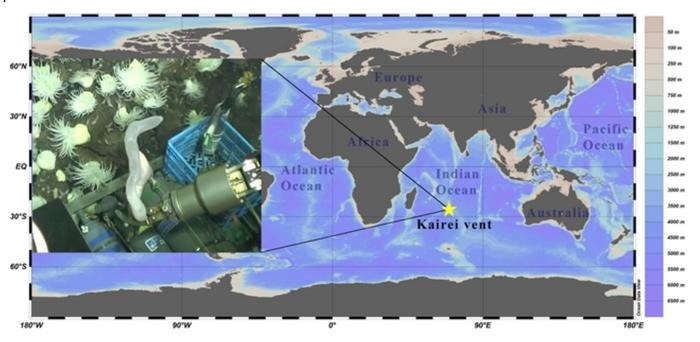Animals are unlikely to thrive in hydrothermal vents because of their harsh chemistry, which includes an acidic pH and a high concentration of methane and sulfur. Not to mention the deep sea's darkness and high hydrostatic pressure.
 The sampling site for the sea cucumber was at the Kairei vent field at the bottom of the Indian Ocean. The inset shows a photo of sampling at a depth of 2,428 m of the sea cucumber Chiridota heheva used for genome sequencing. Image Credit: Pu Y., et al. Gigascience 2023 giad107
The sampling site for the sea cucumber was at the Kairei vent field at the bottom of the Indian Ocean. The inset shows a photo of sampling at a depth of 2,428 m of the sea cucumber Chiridota heheva used for genome sequencing. Image Credit: Pu Y., et al. Gigascience 2023 giad107
Scientists at the Sanya Institute of Deep-sea Science and Engineering in China have completed the sequencing of the entire genome of the sea cucumber Chiridota heheva, an exceptionally unique occupant of the hydrothermal vent environment. The study was published in GigaScience, an open science journal.
The organisms that inhabit hydrothermal vents are some of Earth's most unusual life forms because they have developed specialized adaptations to endure and multiply in these extreme environments. For instance, a lot of microbes use unique metabolic processes to cope with the iron and sulfur abundance and the extreme heat close to the vent.
Multicellular and higher-order organisms, such as different species of worms, snails, crabs, and shrimp, have also adapted to the hydrothermal vent conditions, in addition to microbes.
A specimen of the sea cucumber C. hehevae was collected in 2019 by a Chinese deep-sea expedition using the manned research submarine “Shenhaiyongshi” at the Kairei vent field, 2,428 m below the surface of the Indian Ocean. To make matters worse, the water surrounding the Kairei vent is especially rich in dissolved iron, exacerbating the extreme hydrostatic pressure, darkness, and temperature fluctuations.
As echinoderms, sea cucumbers are related to sea urchins and sea stars, a group of animals with remarkably peculiar body plans. The cucumbers can be found all over the world on sea floors, where they use their tentacles to explore the sediment and eat debris. The work now published in GigaScience is the first genome of a sea cucumber specimen collected at a hydrothermal vent, despite the fact that other high-quality sea cucumber genomes are also available.
According to preliminary comparative genome analyses, this sea cucumber has an expanded repertoire of specific gene sets compared to related species, indicating the expansion of several gene families.
These enlarged and distinct genes are involved in various processes such as iron metabolism and DNA repair, suggesting that the genome of the species reflects its adaptations to the harsh, iron-rich environment. Further research on sea cucumbers and the distinct vent fauna will benefit greatly from the genomic data.
Source:
Journal reference:
Pu, Y., et al. (2024) A high-quality chromosomal genome assembly of the sea cucumber Chiridota heheva and its hydrothermal adaptation. GigaScience. doi.org/10.1093/gigascience/giad107